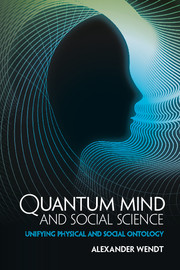Book contents
- Frontmatter
- Dedication
- Epigraph
- Contents
- Acknowledgments
- 1 Preface to a quantum social science
- Part I Quantum theory and its interpretation
- Part II Quantum consciousness and life
- Part III A quantum model of man
- Part IV Language, light, and other minds
- Part V The agent-structure problem redux
- Conclusion
- Bibliography
- Index
Part II - Quantum consciousness and life
Published online by Cambridge University Press: 05 May 2015
- Frontmatter
- Dedication
- Epigraph
- Contents
- Acknowledgments
- 1 Preface to a quantum social science
- Part I Quantum theory and its interpretation
- Part II Quantum consciousness and life
- Part III A quantum model of man
- Part IV Language, light, and other minds
- Part V The agent-structure problem redux
- Conclusion
- Bibliography
- Index
Summary
Introduction
We saw in Part I that in addition to explaining consciousness there is another hard problem for the modern scientific worldview – understanding what quantum physics is telling us about reality. And if anything this one is harder. In philosophy of mind there is at least consensus enough for an orthodox position to exist (materialism), and a widespread expectation that it will be vindicated by future neuroscience. By contrast, in philosophy of physics all sides understand that quantum theory is compatible with a variety of metaphysical interpretations, and have little hope that new empirical discoveries will settle the matter. But both problems are “hard” in the sense that, despite tremendous intellectual effort over many decades, no clear progress has been made toward solving them.
The basic idea of quantum consciousness theory is that bringing the two problems into contact may be the key to solving both (though I will be addressing only the mind–body problem in what follows). That this could be a novel idea attests to the fact that their philosophical discussions have evolved quite separately. While philosophers of physics have long been interested in the role of consciousness in the measurement process, they have engaged little with the mind–body problem per se; and philosophers of mind have been almost unanimous in dismissing the suggestion that consciousness has anything interesting to do with quantum physics. Social scientists might echo such skepticism, wondering how adding the problem of interpreting quantum theory to the problem of consciousness will help them. Besides piling up jargon and arcane debates, in moving to the sub-atomic level we are now even farther removed from the human world, and seemingly poised to engage in the most vulgar reductionism.
Yet, naïvely one might expect the two problems to be related, for two reasons. The first is the intriguing analogies mentioned in Chapter 1 between the mental and quantum domains.
- Type
- Chapter
- Information
- Quantum Mind and Social ScienceUnifying Physical and Social Ontology, pp. 91 - 94Publisher: Cambridge University PressPrint publication year: 2015



